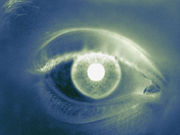Small study found 10 days of electrical stimulation restored some lost vision for some patients
TUESDAY, July 5, 2016 (HealthDay News) — Electrical pulses to the brain may help restore vision in some partially blind patients, according to a study published online June 29 in PLOS ONE.
For the study, investigators focused on 82 partially blind adult patients between 2010 and 2012. Thirty-three had glaucoma, while the rest had other types of optic nerve damage. A little more than half (45) the group was assigned to receive electrical stimulation therapy; the rest received a placebo treatment. Electrical stimulation sessions ranged from 25 minutes on the first day to 50 minutes a day by day 10.
The researchers found that two days after treatment ended, the electrical stimulation group saw a 24 percent improvement, on average, in the ability to perceive objects across their whole field of vision. This improvement was maintained two months out, on average. By comparison, the control group saw less than a 3 percent improvement, which dropped off to almost nothing after two months.
Some patients saw permanent improvements, while others lost their gains over time. What’s more, a third of the electrical stimulation patients did not realize any treatment benefit at all, with no clear indications as to why, study author Bernhard Sabel, Ph.D., of the Otto-von-Guericke University of Magdeburg in Germany, told HealthDay. Still, the treatment was deemed to be safe, with mild side effects and no discomfort during the procedure, he said. Sabel said the findings justify making electrical stimulation available to patients immediately, adding: “We do not need more research to show that it [is] a major step forward.”
Full Text (subscription or payment may be required)
Copyright © 2016 HealthDay. All rights reserved.








